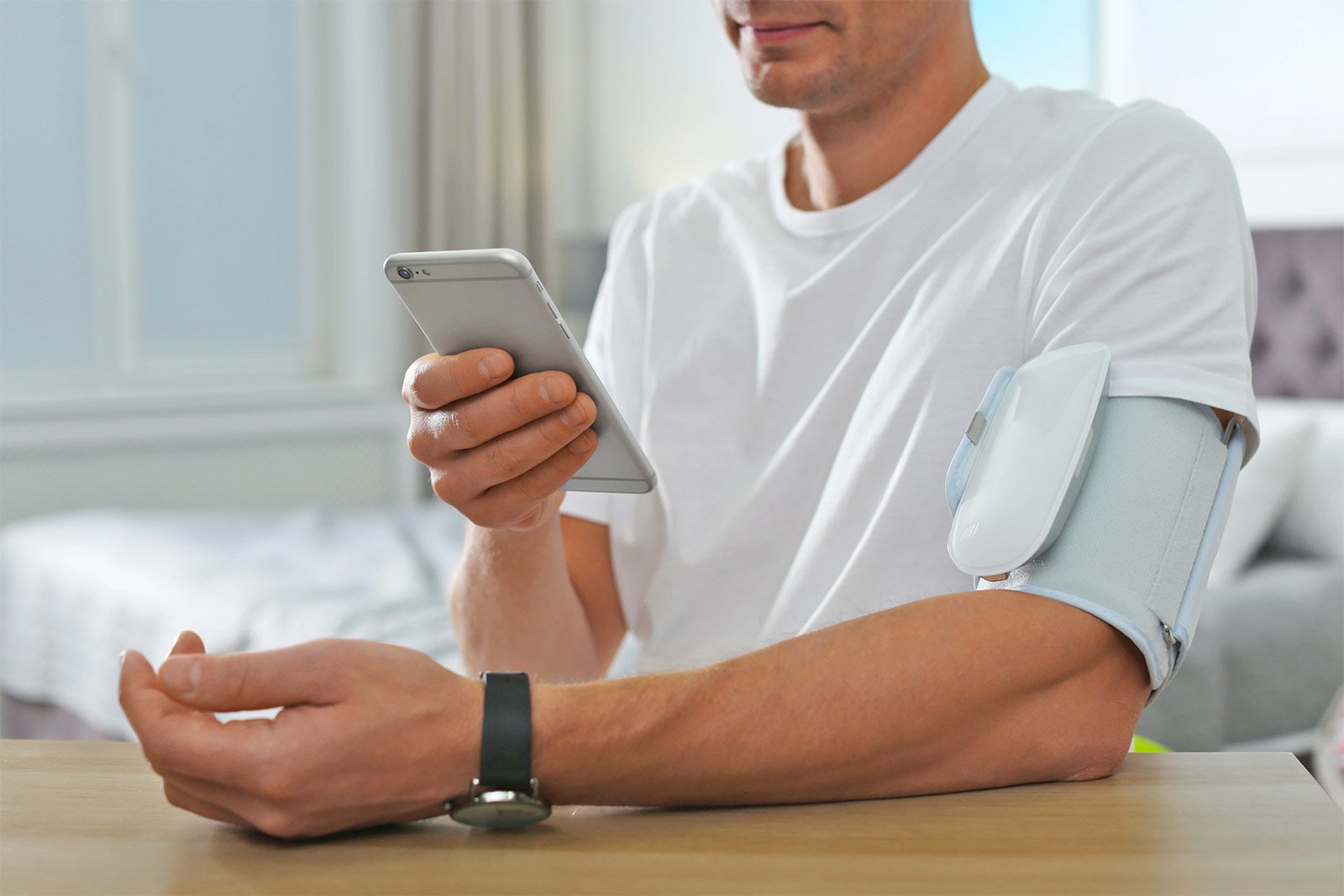The use of remote patient monitoring — i.e., remote physiologic monitoring or RPM — has surged over the past few years. It's been widely embraced by providers, patients, the federal government, and an increasing number of commercial payers. Numerous statistics show the value of RPM, and when we look at some of the more common examples of remote patient monitoring applications, it is easy how RPM is transforming the delivery of care in the United States.
Here are nine of the top patient applications for remote patient monitoring, broken down by three of the practice specialties most frequently offering and prescribing RPM to their patients: cardiology, pulmonology, and endocrinology.
Cardiology Remote Patient Monitoring
Within cardiology, there are four noteworthy examples of remote patient monitoring.
1. Hypertension management
There are many alarming facts and statistics concerning hypertension. Nearly half of U.S. adults can be classified with high blood pressure, and hypertension was a primary or contributing cause of nearly 700,000 deaths in 2021. A patient with hypertension is at risk for heart disease and stroke — the leading causes of death in the United States. Only about one in four adults with hypertension have it under control.
Considering patients with hypertension are usually relatively or completely asymptomatic, the only way to accurately identify whether many patients are experiencing high blood pressure is to measure the blood pressure. That is typically performed with a monitor. Using this blood pressure monitor is a fairly straightforward process, and it's one that lends itself perfectly to RPM. All patients typically must do is place a cuff on their arm and start the accompanying monitoring device that measures and transmits blood pressure data.
Thanks to this simple activity performed on an ongoing basis, cardiologists receive the information they need to advise patients about worthwhile changes in their life in areas including medications, diet, exercise, smoking, drinking alcohol, and consuming caffeine.
2. Medication management and titration
For patients with high blood pressure, treatment is typically ongoing and involves one or more medications. There are many classes of blood pressure medications. As the Mayo Clinic notes, how well a blood pressure medication works can depend on factors including age, sex, race, blood pressure level, and overall health. Combining two drugs usually works better than one to bring blood pressure under control, and sometimes additional medications are required to achieve goals.
Considering these factors, high blood pressure medication regimens often undergo frequent and occasionally substantial changes. To best ensure appropriate and safe adjustments, practitioners need timely and accurate hypertension data. Providing patients with a remote monitoring device is the most effective method for the ongoing delivery of such essential information to cardiologists.
3. Weight measurement for congestive heart failure
Now let us discuss two weight-specific applications for cardiology RPM. As Emory Healthcare reports, nearly 5 million Americans currently live with congestive heart failure (CHF), and heart failure is responsible for 11 million physician visits each year and more hospitalizations than all forms of cancer combined. About 550,000 new cases of heart failure are diagnosed annually in the U.S.
A steady or rapid gain in daily weight may indicate that a patient's body is retaining fluid. Fluid retention — which can occur in the lungs, kidneys, abdomen, legs, and feet — is a common symptom of heart failure. But such weight gain and subsequent fluid retention can easily be missed if not regularly monitored. It has been shown that patients can gain 10 pounds of "extra" fluid weight before showing any symptoms besides increased weight, such as feeling unwell or experiencing swelling.
With daily remote weight monitoring performed using a connected scale, cardiologists receive alerts when cardiac decompensation occurs, permitting fast action that will help improve the patient's condition and decrease the need for hospitalization or urgent care. Daily weight monitoring is considered essential for effective CHF management, with the American heart Association noting that weight gain is often the first indication of worsening heart failure.
4. Weight measurement for obesity
Our final example of cardiology remote patient monitoring also involves measuring and monitoring weight. Obesity is one of the most significant health problems for Americans, with about 42% of the U.S. population considered obese in 2017–2020. Health problems linked to being overweight and obesity include high blood pressure and heart disease as well as type 2 diabetes, strokes, and some forms of cancer.
The good news is that obesity is treatable and reversible, and doing so can deliver numerous health benefits that include decreasing serious health risks, reducing cholesterol levels, and addressing sleep apnea. With ongoing, remote monitoring of a patient's obesity, cardiologists can provide better and more targeted advice for changes that can help stabilize or decrease weight.
Pulmonology Remote Patient Monitoring
Continuing through our list of nine top patient applications for remote patient monitoring, there are two examples of remote patient monitoring frequently offered by pulmonologists and a third example encompassing multiple conditions.
1. COPD management
Chronic obstructive pulmonary disease (COPD) is the third leading cause of death by disease in the United States. The disease affects about 12 million Americans, and it is believed that millions more are not aware they have COPD. The disease accounts for millions of emergency department visits.
COPD may be incurable, but it is manageable and treatable. To do so, pulmonologists work with patients to develop a plan that combines medications, oxygen therapy, rehabilitation, and support. With remote patient monitoring, pulmonologists can perform effective and timely oversight of COPD. This leads to improvements in decision support and patient adherence to guidance and recommendations.
2. Asthma management
Statistics show that more than 27 million U.S. adults — or about 8% — have asthma. While asthma remains incurable, it's highly treatable. Pulmonologists can work with patients to develop a management plan that combines exercise, avoiding triggers, medications, and other strategies, including remote patient monitoring. On the rise among asthma patients, the use of an electronic respiratory monitor is serving to support asthma patients and help optimize asthma management. And with good reason: Studies indicate that ongoing monitoring of interventions is linked to better asthma control, more symptom-free days, and decreased need for rescue medication.
3. Other respiratory disease management
Pulmonologists are largely leveraging RPM to support COPD and asthma patients, but there has been an increase in remote support for patients with cystic fibrosis (CF), bronchiectasis, and other respiratory diseases. As pulmonologists and their patients further embrace RPM, the number of patients with varying diseases who benefit from these virtual services will steadily increase.
Endocrinology Remote Patient Monitoring
For our final top patient applications for remote patient monitoring, let's look at two common examples of endocrinology remote patient monitoring.
1. Glucose monitoring
The American Diabetes Association reports that in 2021, more than 38 million Americans, or close to 12% of the population, had diabetes, and more than 1.2 million Americans are diagnosed with diabetes annually. Like other diseases discussed in this piece, diabetes is chronic and incurable, but there are several ways to reduce the impact of the disease on a patient's life, including weight loss, positive diet changes, and engaging in an active lifestyle.
Blood sugar testing is essential to better managing diabetes and preventing complications. Such testing not only serves to identify when blood sugar levels are high or low, but it also helps with diabetes medication management, evaluation of the effects from changes to diet and exercise, and tracking progress toward treatment goals.
For some diabetes patients, blood sugar testing is recommended periodically up to a few times daily. These patients are increasingly receiving remote support for their diabetes management via a blood glucose meter. When patients test their blood sugar using this glucose monitoring device, endocrinologists receive the data captured. If the information warrants it, these practitioners can make changes to a medication regimen and provide recommendations to improve management. Evidence shows that RPM is effective in controlling HbA1c levels in people with type 2 diabetes
2. Continuous Glucose Monitoring
For people with diabetes, mainly those with type 1 diabetes, ongoing measurement of blood sugar levels may be recommended to detect noteworthy changes in blood sugar levels in near real-time and reveal sugar level highs and lows that fingerstick testing alone may not identify. To perform ongoing measurement, patients are provided a continuous glucose monitoring system, often referred to as a CGM. To use a CGM, a small sensor is attached to the abdomen that includes a cannula. The cannula penetrates the skin and performs the "continuous measurement" around the clock (there's a few-minute interval between readings). The data captured is then sent to a device. If it's an RPM device, the equipment transmits the information to the prescribing practice for review within the remote patient monitoring system.
As with remote, non-continuous glucose monitoring, remote CGM provides endocrinologists with their patient's blood sugar readings — and most importantly, any that raise red flags (i.e., glucose levels too high or low). CGM can help improve diabetes management and treatment decisions as it provides a clearer picture of a patient's blood sugar levels and their movement.
Get Started With Remote Patient Monitoring
Do you treat patients with any of the diseases discussed above and think your patients would benefit from remote patient monitoring? The next step is to find an RPM system that will meet your and their needs. We invite you to schedule a live demo of Prevounce. The Prevounce platform and support from our RPM experts function as a partner that can guide you through the remote patient monitoring process and help you identify the equipment and software that best meets your patients' and organization's needs.
If you're unsure about whether RPM will make financial sense for your organization, we suggest downloading our RPM billing guide and using our ROI calculator.






